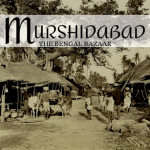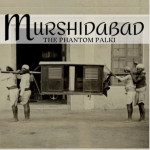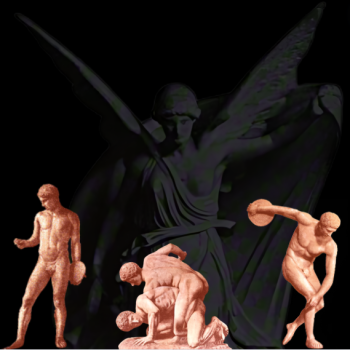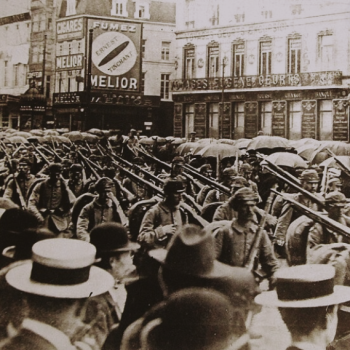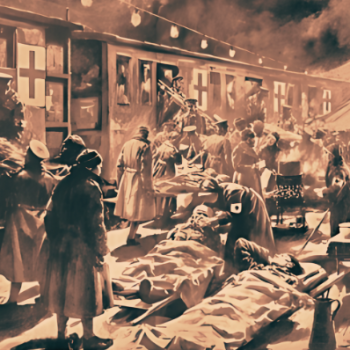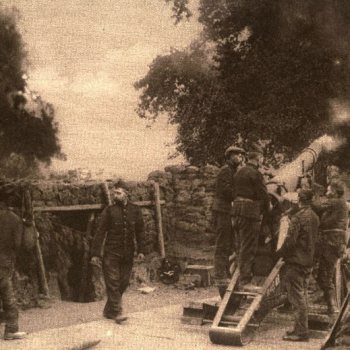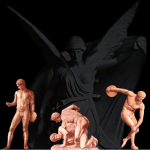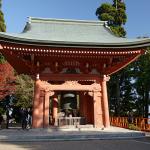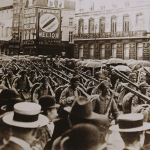Johnston tells us that one day during camp the Nawab sent a messenger to extend an invitation to the palace, to visit the treasury.[1] The Nawab, at the time, was preparing to distribute prizes to the successful students at his High School.[2] Private courtly intrigue was becoming public courtly intrigue at the time, for in November 1888, after a long journey from London, Sarah Begum arrived in India with the intention retrieving her daughters (Miriam and Vaheedoonissa) from the palace.[3] Having spent a decade in the palace with their grandmother, Gaddanashin Begum (First Lady,) also called the grandmother the girls considered India their home, and did not want to return with their mother.[4] During the weeks since her arrival at Hazarduari, Sarah Begum was the source of much anxiety. The stress of the situation caused the Nawab to suffer a paralytic seizure.[5] In Ritchies memoir, he provided the following account:
We were much exercised and at the same time amused by Sarah Begum, an Englishwoman with whom the late Nawab had gone through some sort of marriage ceremony before the Lord Mayor of London. Sarah was of humble origin, but looked every inch a queen. She came to enforce her supposed rights, and to claim her two daughters, who were being brought up in the Zenana, though she had formally resigned the custody of them. She lived at the palace at war with the world of Mahommedan relations, complaining of being insulted and of attempts being made on her life. The Nawab himself was a gentlemanly old Musalman, bearing strong traces in his features and thick lips of the Abyssinian slave-girl who was his mother. Theo looked at him with wonder. He was much troubled by Sarah Begum, his step-mother, and in the midst of the embarras caused by her presence the poor old gentleman had a paralytic seizure. He did not care for his huge palace, and when I went to see him, he was lying in a little insignificant (darwan’s) or doorkeeper’s lodge. A monkey was playing about and a miscellaneous and interested crowd of relations was surrounding him. All the riff-raff of the town were crowding outside. It was a pathetic spectacle.[6]
Jyotishi’s prediction proved to be true, so the Nawab consulted him once again to discern the likelihood of recovery. Jyotishi was optimistic of recovery, “adding that certain rites should be performed after the Hindu astrology for the propitiation of the evil planets.” Following this, Jyotishi had some unpleasant dealings with some court officials “who tried hard to estrange the Jyotishi from the Nawab.” Their efforts would prove to be in vain, for Fazl Rubbee fully supported Jyotishi’s relationship with the prince.[7]
—S.H.
EMERALDS OF SOMNATH
Charles Johnston.
November 1889.
One sunny morning, our tents were pitched in a cool, leafy mango trope, not far from the Palace of the Nawab. We were resting after a three-hours ride, under the trees, watching the grey squirrels flashing among the leafy boughs, and listening to the soft crooning of the turtle-doves, or the distant tap of the scarlet-capped woodpecker—the “carpenter bird,” the Indians call it. Overhead the kites wove their mazy circles, now and then breaking the silence with a shrill cry. The Indian calm was broken by a red-turbaned messenger bearing the salaams of the Nawab, and an invitation to visit.
When we arrived at the palace, we were received by Rubbee, but His Highness, very cordially, offered to take us and show us his Treasury. The Nawab led the way along corridors under a magnificent painting by Vandyke, the present some Anglo-Indian ruler, to a small chamber, whose door was heavily barred with steel; where the last treasures of his once magnificent dynasty were guarded by a dusky Sepoy with dark, scowling face. We were asked to be seated beside the Nawab in an ante-room, while the iron doors that shut the treasury were rolled back, and the more notable jewels were laid before us on the table. [8] The Nawab showed us all kinds of wonderful and costly things gold and silver, gleanings from Aladdin palaces, which filled Verochka’s heart with joy. We were shown, first, some beautiful armlets of table diamonds, rather flat and lusterless from the Eastern fashion of cutting; then cases of topazes, amethysts and chrysoprase; then a curious aigrette of diamonds of all colors, pink and yellow, and red and dark brown, and purple; an almost unique series of varieties of the beautiful queen of gems. To those succeeded old sword-hilts and sheaths of gold and jewels, precious caskets and rings and bracelets, in delicate golden filigree, and the finest chisel work of the East. Particularly entrancing to her were the good prince’s personal adornments, kept here for safety; aigrettes of table diamonds and rubies, a set of emerald buttons, each as large as one’s finger-nail, a full score in number; and, final glory, three huge table emeralds, each as large as Verochka’s visiting card, which the good prince wore as belt buckles—one at a time, of course.[9]
We saw many queer things in the armory; steel guards for war elephants’ tusks, maces made of spiky iron balls chained to a pole, swords with rippled blades, that must slip through a man very feelingly, tulwars, daggers, krises, triangular knives from Kabul, poniards from Java, and old Toledo and Genoa blades—notably an Andrea Ferrara that you could bend nearly double by pressing the point on the floor.[10]
The Nawab made a sign to Rubbee, who, in flowery oriental phrase, like some Sadi or Jellaladin at the Caliph’s court, related the story of the diamonds and how they came to his master’s house.
“When the fierce Mahmud of Ghazni,” he said, “swept down with his wild hordes like the locusts of Arabia on the rich plains and fertile valleys of India, he beat back and subdued the idolatrous Hindus on all the rivers of the Punjab, and swept down with resistless force to the thrice sacred shrine of Somnath. Two motives drove the wild warrior of Ghazni to knock at that sacred temple: First, to destroy the idols of the unbelievers; then to glean the vast treasure swept together from a thousand Golcondas to the most sacred shrine in the East The temple doors were broken open. The holy halls were filled with wild mountain warriors. They swarmed hither and thither through the temple among the calmly despairing Brahmans, and found nothing, not a gem, not a piece of gold, but only a great stone pillar daubed with paint, the Mahadeo, or Great God, of the idol-worshiping Hindus. Mahmud of Ghazni was wroth, and swore in his anger to destroy the shrine and to break down the idol, and to offer his fragments to Allah, the one merciful and compassionate God.
“Then the Brahmans broke out in cries and wailings, and prayed Mahmud to spare their god. From a secret crypt in the temple, they brought forth gold and offered him the weight of three men in golden mohurs if he would spare the stone pillar and not destroy their shrine.
“But Mahmud was inexorable. Raising his sword and striking once, he wondered at the hollow ring of the pillar, and struck a second time with his steel against the stone. Then the pillar of stone fell open, and from the opening poured out gold and diamonds, and rubies and sapphires, and topazes and emeralds…a countless treasure of gems.
“Then Mahmud gathered the treasure and the gold and the precious stones, and took them with him to Ghazni, where they lay for centuries in his treasury.
“Then after centuries the hordes of the Mussulman again swept over India and brought with them the jewels and the emeralds of Somnath.
“For years the jewels lay in the gold heaped treasuries of Delhi till the spider had spun her web over them, and the lizard had made his nest in the hollow cups of gold.”[11]
One could see Verochka warming to the point where she must inevitably ask more questions. His gentle Highness who I think was secretly not a little diverted by the vivacious lady, and who showed her many marks of kindly friendship, caught the coming question in her eyes smiled a little smile of amusement and anticipated inquiry by telling us a tale of the brave of old days.
“I can easily tell you that, madame,” said the prince with that shy smile of his. “They were stolen by one of my predecessors. When the Emperor Alam Gir lay dying in his palace at Delhi, the great viceroys were gathered round him; the Nawab of Oudh, the Prince of Kashmir, and the Nawab of Bengal. His Majesty took a long time dying, much longer than they had expected; and the three great viceroys found the time hanging somewhat heavily on their hands. So they diced awhile, and then, growing weary of this also, they went to look at the Grand Mogul’s Treasury. From looking, they came to longing; and the upshot of it all, was that they determined to anticipate the possible testamentary dispositions of the Mogul Emperor, and divide his treasure then and there. Kashmir got the sapphires,” he said, with a quaintly humorous smile, “Oudh got the diamonds; and as for the emeralds, why, here they are!”
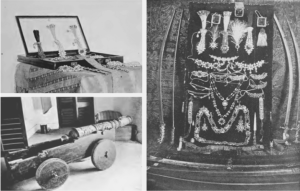
(Top left) Some of the Murshidabad family jewels.
(Bottom left.) The “Nadia” Cannon. (Right) family jewels and sabers.[12]
Eugène had been bon enfant too long, and now had a reaction. He yielded to the temptation to make light mischief.
“Ah, those were the good times, before the English came!” he said; “do you not wish they were back again?”
There was a touch of personal feeling in this, too; for had not Eugène’s own people held great empire once, as rivals of the English, and even fought in the Nawab’s army at Plassey against the indomitable-hearted Clive?—fought, and been defeated, though Clive was outnumbered twenty to one. The good Nawab smiled.
“You must remember,” he said, “that my ancestors were very good friends of the English, even before Plassey. We pulled together with Clive, and Clive helped us into power, when Siraj ud-Daulah fell by the weight of his own evil stupidity. We have always been very good friends.”
Here I ventured to ask a question, which might, perhaps, have been indiscreet:—
What, in the good Nawab’s view, was the chief difference brought in by English rule?
The Nawab reflected. One could see reminiscence and half-stifled regret chase each other in his kindly brown eyes. Then at last he spoke:—
“For the poorest people, and that means the vast majority in India, the change has been greatest. And I think the greatest change of all has been this, that, under English rule, every peasant knows exactly what he must pay in taxes. That, it has always seemed to me, is the weakest part of our Mussulman systems; it is always just the same thing, whether in Macedonia, or in Egypt, or here in Bengal. The imperial government farms out the collection of the revenue, and the tax-farmers mercilessly oppress the people with their extortions. You can hardly realize what a horrible mountain of suffering and misery may grow from that one thing; a far greater total, it seems to me, than even the violence of pillage and war. That came seldom, but the hawks and vultures were always there, and no man knew what he must pay, or what he could keep. That seems to me the greatest boon; yet our peasants are poor, miserably poor.” He was silent, his face clouded over and touched with pain, and his lips again murmured, “miserably poor.”
Here seems to me the touch of tragedy in this gentle prince’s life, that he sees so much misery, which makes so strong an appeal to his heart, and yet, with all his titles and decorations, has so little power to counteract it, save by ample doles of charity, which, from certain reasons, I knew him constantly to make. There might well have been some wider field of work for his good, gentle heart. I imagined him thinking, though he did not say it, “You have done most for the poorest and most wretched; but, for the rest of us, you weigh somewhat heavily on our souls!”
But that may be a fancy. His Highness rose, with something of a sigh, and invited Verochka to pay a visit to his “mothers,” as he said, in his courtly way, and also to one splendid grandmother, a very queen of the ancient world. Verochka told us wonderful stories of that visit, and of the marvels she saw and heard.[13]
She was conducted by the good prince to the “city of the ladies,” a little walled paradise within the park of the palace. Passing through many gates, she at last entered a court of the Thousand and One Nights, paved with marble tiles, alternate green and yellow. A fountain fell into a rosy basin in the midst, and the spray set tinkling numberless little silver bells. Under an arch of marble lacework sat Her Highness, Gaddanashin Begum, also called the grandmother, all in white among her ladies.[14] She wore her gray hair loose, cut short over her eyes and at her neck; black silk mittens, and stockings à jour of the same, completed her attire, for she wore no shoes. As a widow, she had no jewels. Her ladies were all in white, and gaunt eunuchs fanned her with peacock and ostrich fans. With great ceremony the grandmother received her visitor, being indeed there to that end; for she dwells in a house boat on the river, and cannot sleep without the murmur of the waves. She had a great longing to hear about snow, which she had dreamed of, but never seen. At parting, she put a wreath round Verochka’s neck—woven of red and gold braids—and added handfuls of roses.
Then the Nawab and his guest went to see his wife, Amir Dulhan Kulsum-un-nisa Begum, who lives in a charming little dwelling, with the daintiest garden; flower beds all bright primness, little lakes, pink marble bridges, dwarf cypress trees, like dark green flames, and roses—everywhere roses. The little lady wore her hair with two partings, and had a delicate, well-born face; her daughter was with her, but her boys were at Rugby, an incongruous addition to this eastern dream, but so it was.
Then they visited one of the mothers, who had the dearest little grandsons in bright satins and gold lace; for gay colors are in vogue within the palace. Here they talked history, and the Nawab said his grandmother was still full of memories of the days when she was a veritable queen, and ruled a husband who ruled fifty millions of Bengalis. They have never told her that those bright days are gone, and she still thinks her sons are reigning sovereigns.[15] And so she dreams on, in her marble courtyard, and her house boat on the Ganges, and is well content.[16]
There is much in this Oriental life that must forever be hidden from us; the secrets hidden by the curtains of the seraglios, the thoughts of the eunuchs, as they listen to the water bubbling in their tobacco pipes of coconut, the intrigues of the younger brothers and their kin against the dominance of the elder brother, and the dim ambitions, despondent dreams and imaginings of the conquered land—all this is hidden in mystery, but one thing we can understand as going deeper than difference of grace and creed and clime, and that is the old man’s simple charity that helps the needy and feeds the hungry.[17]
← Table Of Contents →
SOURCES:
[1] Johnston, Charles. “A Nawab’s Jewels.” The Providence Journal. (Providence, Rhode Island) August 30, 1891.
[2] “Murshidabad High School.” The Englishman’s Overland Mail. (Calcutta, India) November 5, 1889.
[3] “Court And Personal News.” The Globe. (London, England) October 18, 1889; “Passengers Per S.S. ‘Chusan.’” The Englishman’s Overland Mail. (London, England) November 26, 1889.
[4] Innes, Lyn. The Last Prince of Bengal. The Westbourne Press. London, England. (2021): 75-134.
[5] Majumdar, Purna Chundra. The Musnud Of Murshidabad (1704-1904): Being A Synopsis Of The History Of Murshidabad For The Last Two Centuries. Saroda Ray. Murshidabad, India. (1905): 62.
[6] Ritchie, John Gerald. The Ritchies In India: Extracts From The Correspondence Of William Ritchie, 1817-1862. J. Murray. London, England. (1920): 368-369.
[7] De, Tarini Prasad Jyotishi, 1902): 81-82.
[8] “A Nawab’s Jewels.” The Providence Journal. (Providence, Rhode Island) August 30, 1891.
[9] In “A Nawab’s Jewels,” Johnston writes: “But the finest of all, and most remarkable, are the Murshidabad emeralds, some score in number, as large as shillings, mounted in gold in the form of buttons; and three pre-eminent stones, each as large as a lady’s visiting card, and full of green mysteries in their gleaming depths. As these three gems were laid on the table the Nawab made a sign to Rubbee, who, in flowery oriental phrase, like some Sadi or Jellaladin at the Caliph’s court, related the story of the diamonds and how they came to his master’s house.” [Johnston, Charles. “A Nawab’s Jewels.” The Providence Journal. (Providence, Rhode Island) August 30, 1891.]
[10] Johnston, Charles. “A Prince Of India.” The Puritan. Vol. V., No. 2. (March 1899): 309-319.
[11] “A Nawab’s Jewels.” The Providence Journal. (Providence, Rhode Island) August 30, 1891.
[12] Walsh, J.H. Tull. A History Of Murshidabad District (Bengal) : With Biographies Of Some Of Its Noted Families. Jarrold & Sons. London, England. (1902): 48-49; Majumdar, Purna Chundra. The Musnud Of Murshidabad (1704-1904): Being A Synopsis Of The History Of Murshidabad For The Last Two Centuries. Saroda Ray. Murshidabad, India. (1905): 98.
[13] Johnston, Charles. “His Highness The Nawab: Helping To Govern India.” The Atlantic Monthly. Vol. CVIII, No. 4. (December 1911): 797-804.
[14], Innes Lyn. The Last Prince of Bengal. The Westbourne Press. London, England. (2021): 75-134.
[15] In “Mussulman Festival,” Johnston writes: “Every prominent Mohammedan in the city had a tazia in the procession, the first being sent by the grandmother of the Nawab, a great lady, who, in her secluded harem, still remembered the days when the royalty of her house was something more than a name.” [Johnston, Charles. “Mussulman Festival.” The Providence Journal. (Providence, Rhode Island) December 4, 1898.]
[16] Johnston, Charles. “A Prince Of India.” The Puritan. Vol. V., No. 2. (March 1899): 309-319.
[17] “An Indian Prince.” The Providence Journal. (Providence, Rhode Island): September 12, 1897; Johnston, Charles. “His Highness The Nawab: Helping To Govern India.” The Atlantic Monthly. Vol. CVIII, No. 4. (December 1911): 797-804.


